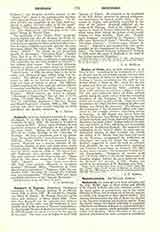

Regionarii, the name given in later antiquity and the early Middle Ages to those clerics and officials of the Church in Rome who were attached neither to the papal palace or patriarchium, nor to the titular churches of Rome, but to whom one of the city regions, or wards, was assigned as their official district. For internal administration the city of Rome was divided by the Emperor Augustus into fourteen regions. From the fourth century developed (evidently in connection with the seven Roman deacons) an ecclesiastical division into seven regions, which gradually replaced the earlier civil divisions. Many branches of the ecclesiastical administration were arranged in accordance with the seven regions—especially the care of the poor, provision for the maintenance of the churches, and whatever else pertained primarily to the office of the deacons, one of whom was appointed over each of the seven regions (diaconus regionarius). As the deacons were assisted by seven subdeacons, we also find the term subdiaconus regionarius. The notaries and defensores employed in the administration of the regions were also known as notarii regionarii and defensores regionarii. There is also occasional mention of acolyti regionarii. Little is known about the functions exercised by these regionarii, as in general concerning the ecclesiastical administration in ancient Rome, in as far as it affected the regions.
J. P. KIRSCH

